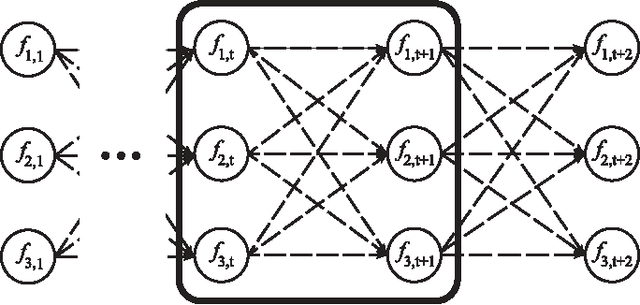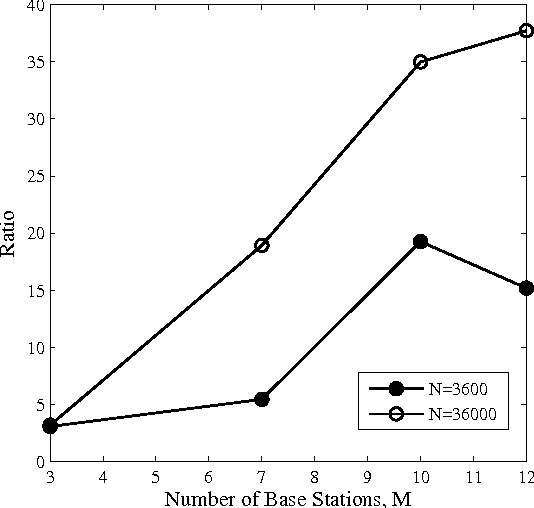Min Sheng
Dynamic Trajectory Optimization and Power Control for Hierarchical UAV Swarms in 6G Aerial Access Network
Aug 26, 2025



Abstract:Unmanned aerial vehicles (UAVs) can serve as aerial base stations (BSs) to extend the ubiquitous connectivity for ground users (GUs) in the sixth-generation (6G) era. However, it is challenging to cooperatively deploy multiple UAV swarms in large-scale remote areas. Hence, in this paper, we propose a hierarchical UAV swarms structure for 6G aerial access networks, where the head UAVs serve as aerial BSs, and tail UAVs (T-UAVs) are responsible for relay. In detail, we jointly optimize the dynamic deployment and trajectory of UAV swarms, which is formulated as a multi-objective optimization problem (MOP) to concurrently minimize the energy consumption of UAV swarms and GUs, as well as the delay of GUs. However, the proposed MOP is a mixed integer nonlinear programming and NP-hard to solve. Therefore, we develop a K-means and Voronoi diagram based area division method, and construct Fermat points to establish connections between GUs and T-UAVs. Then, an improved non-dominated sorting whale optimization algorithm is proposed to seek Pareto optimal solutions for the transformed MOP. Finally, extensive simulations are conducted to verify the performance of proposed algorithms by comparing with baseline mechanisms, resulting in a 50% complexity reduction.
Cooperative Tri-Point Model-Based Ground-to-Air Coverage Extension in Beyond 5G Networks
Jan 18, 2024Abstract:The utilization of existing terrestrial infrastructures to provide coverage for aerial users is a potentially low-cost solution. However, the already deployed terrestrial base stations (TBSs) result in weak ground-to-air (G2A) coverage due to the down-tilted antennas. Furthermore, achieving optimal coverage across the entire airspace through antenna adjustment is challenging due to the complex signal coverage requirements in three-dimensional space, especially in the vertical direction. In this paper, we propose a cooperative tri-point (CoTP) model-based method that utilizes cooperative beams to enhance the G2A coverage extension. To utilize existing TBSs for establishing effective cooperation, we prove that the cooperation among three TBSs can ensure G2A coverage with a minimum coverage overlap, and design the CoTP model to analyze the G2A coverage extension. Using the model, a cooperative coverage structure based on Delaunay triangulation is designed to divide triangular prism-shaped subspaces and corresponding TBS cooperation sets. To enable TBSs in the cooperation set to cover different height subspaces while maintaining ground coverage, we design a cooperative beam generation algorithm to maximize the coverage in the triangular prism-shaped airspace. The simulation results and field trials demonstrate that the proposed method can efficiently enhance the G2A coverage extension while guaranteeing ground coverage.
Energy-Efficient Power Control for Multiple-Task Split Inference in UAVs: A Tiny Learning-Based Approach
Dec 31, 2023Abstract:The limited energy and computing resources of unmanned aerial vehicles (UAVs) hinder the application of aerial artificial intelligence. The utilization of split inference in UAVs garners significant attention due to its effectiveness in mitigating computing and energy requirements. However, achieving energy-efficient split inference in UAVs remains complex considering of various crucial parameters such as energy level and delay constraints, especially involving multiple tasks. In this paper, we present a two-timescale approach for energy minimization in split inference, where discrete and continuous variables are segregated into two timescales to reduce the size of action space and computational complexity. This segregation enables the utilization of tiny reinforcement learning (TRL) for selecting discrete transmission modes for sequential tasks. Moreover, optimization programming (OP) is embedded between TRL's output and reward function to optimize the continuous transmit power. Specifically, we replace the optimization of transmit power with that of transmission time to decrease the computational complexity of OP since we reveal that energy consumption monotonically decreases with increasing transmission time. The replacement significantly reduces the feasible region and enables a fast solution according to the closed-form expression for optimal transmit power. Simulation results show that the proposed algorithm can achieve a higher probability of successful task completion with lower energy consumption.
Robust TOA-based Localization with Inaccurate Anchors for MANET
Dec 29, 2023Abstract:Accurate node localization is vital for mobile ad hoc networks (MANETs). Current methods like Time of Arrival (TOA) can estimate node positions using imprecise baseplates and achieve the Cram\'er-Rao lower bound (CRLB) accuracy. In multi-hop MANETs, some nodes lack direct links to base anchors, depending on neighbor nodes as dynamic anchors for chain localization. However, the dynamic nature of MANETs challenges TOA's robustness due to the availability and accuracy of base anchors, coupled with ranging errors. To address the issue of cascading positioning error divergence, we first derive the CRLB for any primary node in MANETs as a metric to tackle localization error in cascading scenarios. Second, we propose an advanced two-step TOA method based on CRLB which is able to approximate target node's CRLB with only local neighbor information. Finally, simulation results confirm the robustness of our algorithm, achieving CRLB-level accuracy for small ranging errors and maintaining precision for larger errors compared to existing TOA methods.
Coordinated Intra- and Inter-system Interference Management in Integrated Satellite Terrestrial Networks
Dec 13, 2023



Abstract:Leveraging the advantage of satellite and terrestrial networks, the integrated satellite terrestrial networks (ISTNs) can help to achieve seamless global access and eliminate the digital divide. However, the dense deployment and frequent handover of satellites aggravate intra- and inter-system interference, resulting in a decrease in downlink sum rate. To address this issue, we propose a coordinated intra- and inter-system interference management algorithm for ISTN. This algorithm coordinates multidimensional interference through a joint design of inter-satellite handover and resource allocation method. On the one hand, we take inter-system interference between low earth orbit (LEO) and geostationary orbit (GEO) satellites as a constraint, and reduce interference to GEO satellite ground stations (GEO-GS) while ensuring system capacity through inter-satellite handover. On the other hand, satellite and terrestrial resource allocation schemes are designed based on the matching idea, and channel gain and interference to other channels are considered during the matching process to coordinate co-channel interference. In order to avoid too many unnecessary handovers, we consider handover scenarios related to service capabilities and service time to determine the optimal handover target satellite. Numerical results show that the gap between the results on the system sum rate obtained by the proposed method and the upper bound is reduced as the user density increases, and the handover frequency can be significantly reduced.
Cognitive Learning of Statistical Primary Patterns via Bayesian Network
Feb 09, 2015



Abstract:In cognitive radio (CR) technology, the trend of sensing is no longer to only detect the presence of active primary users. A large number of applications demand for more comprehensive knowledge on primary user behaviors in spatial, temporal, and frequency domains. To satisfy such requirements, we study the statistical relationship among primary users by introducing a Bayesian network (BN) based framework. How to learn such a BN structure is a long standing issue, not fully understood even in the statistical learning community. Besides, another key problem in this learning scenario is that the CR has to identify how many variables are in the BN, which is usually considered as prior knowledge in statistical learning applications. To solve such two issues simultaneously, this paper proposes a BN structure learning scheme consisting of an efficient structure learning algorithm and a blind variable identification scheme. The proposed approach incurs significantly lower computational complexity compared with previous ones, and is capable of determining the structure without assuming much prior knowledge about variables. With this result, cognitive users could efficiently understand the statistical pattern of primary networks, such that more efficient cognitive protocols could be designed across different network layers.
 Add to Chrome
Add to Chrome Add to Firefox
Add to Firefox Add to Edge
Add to Edge